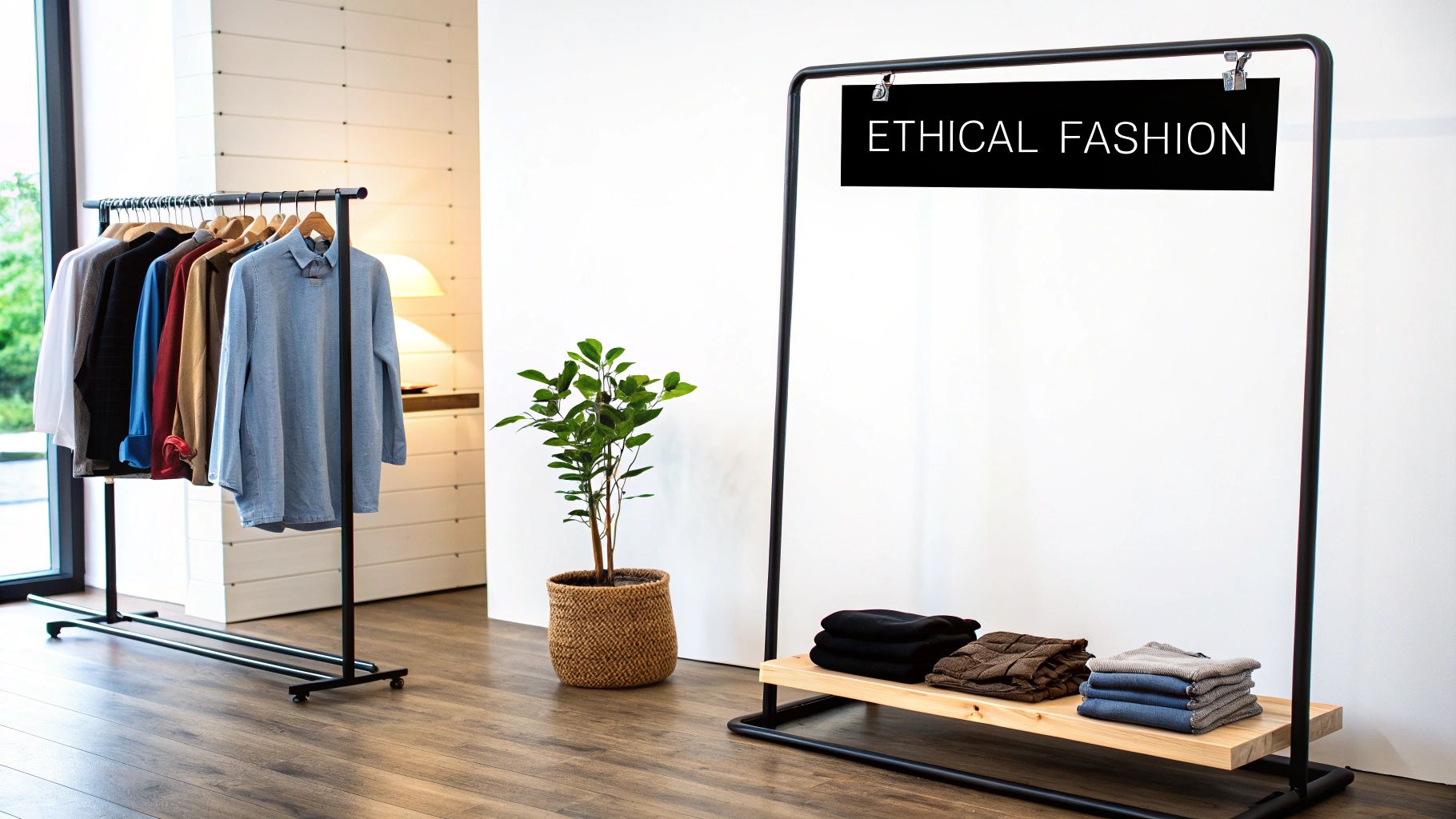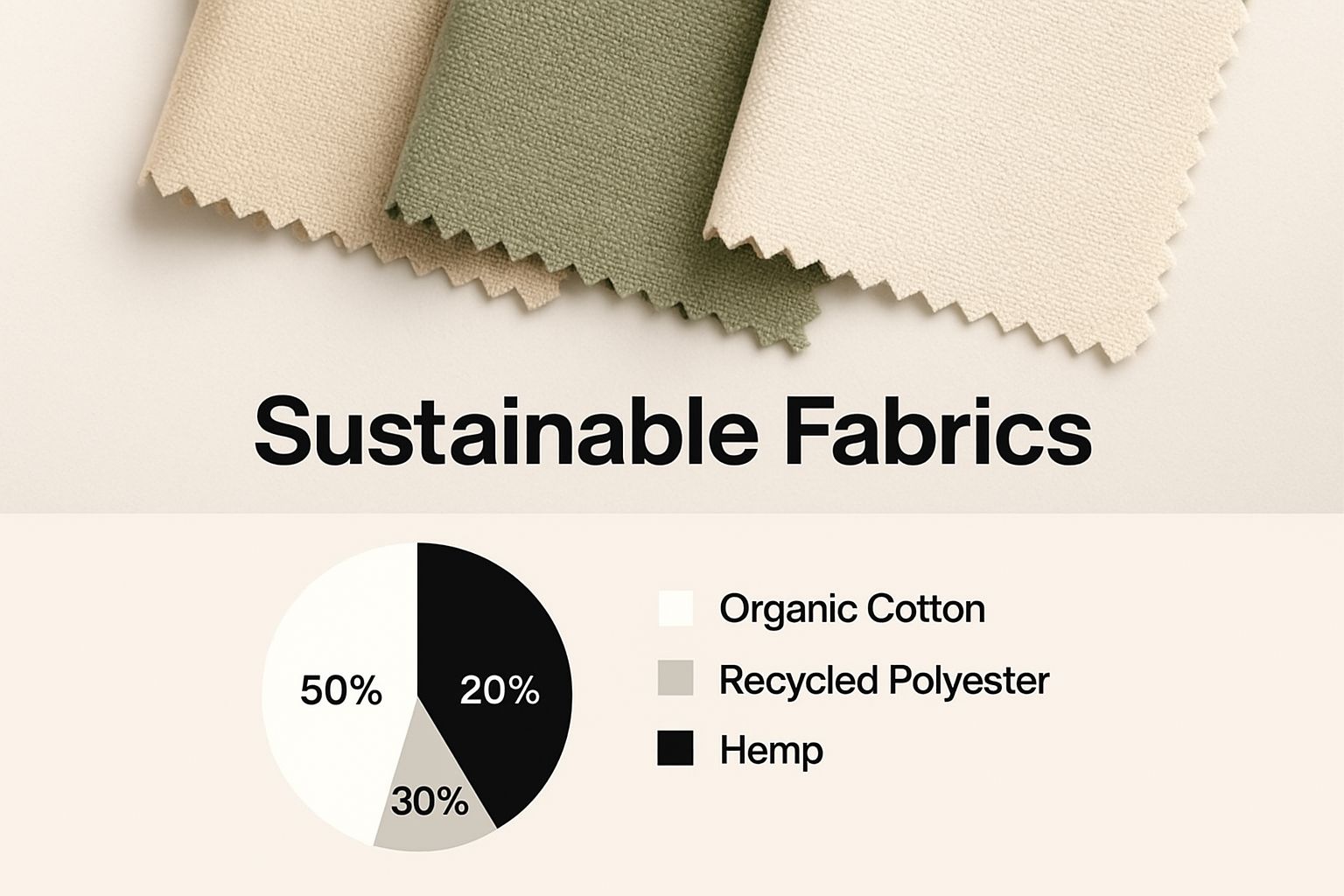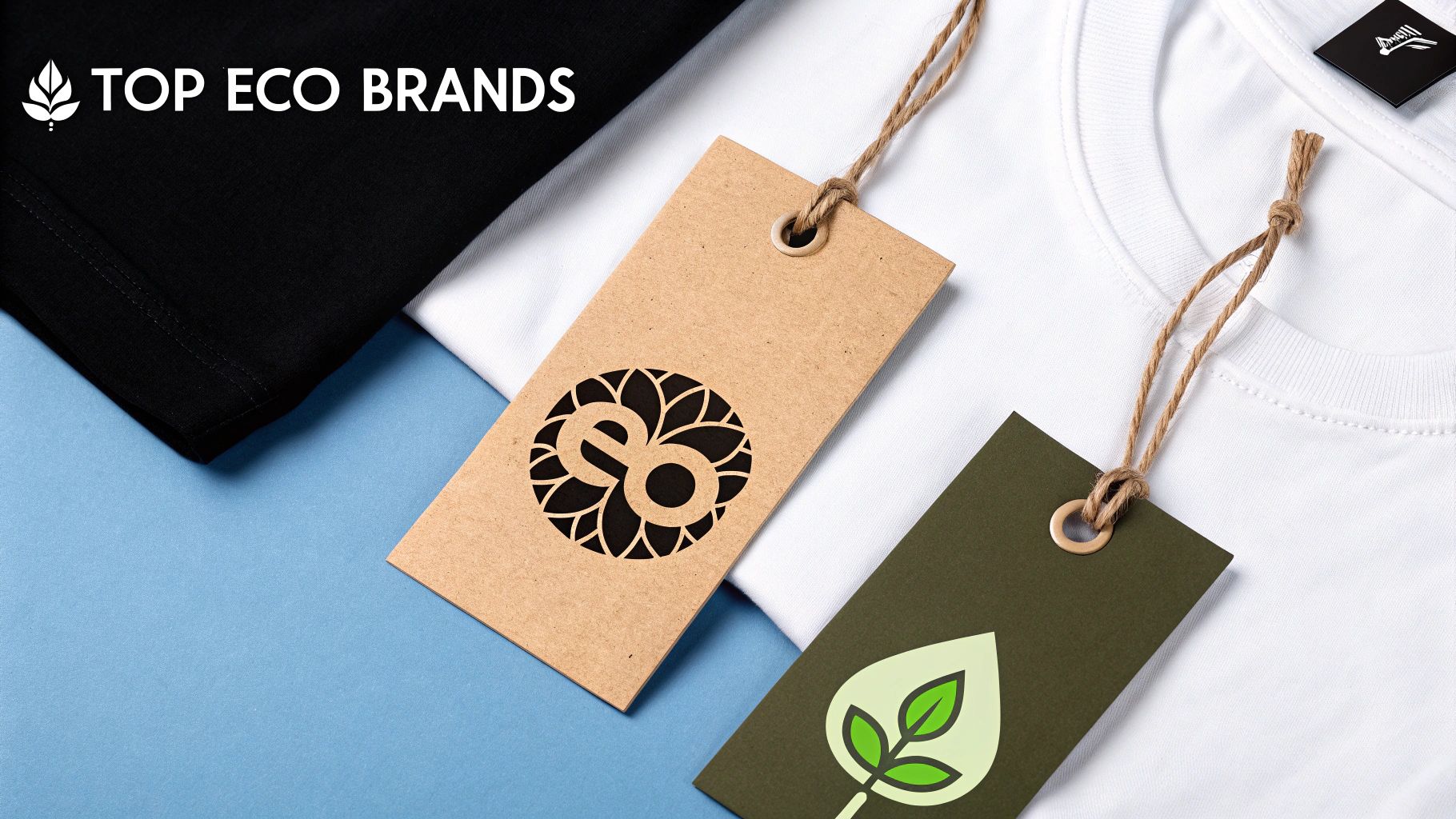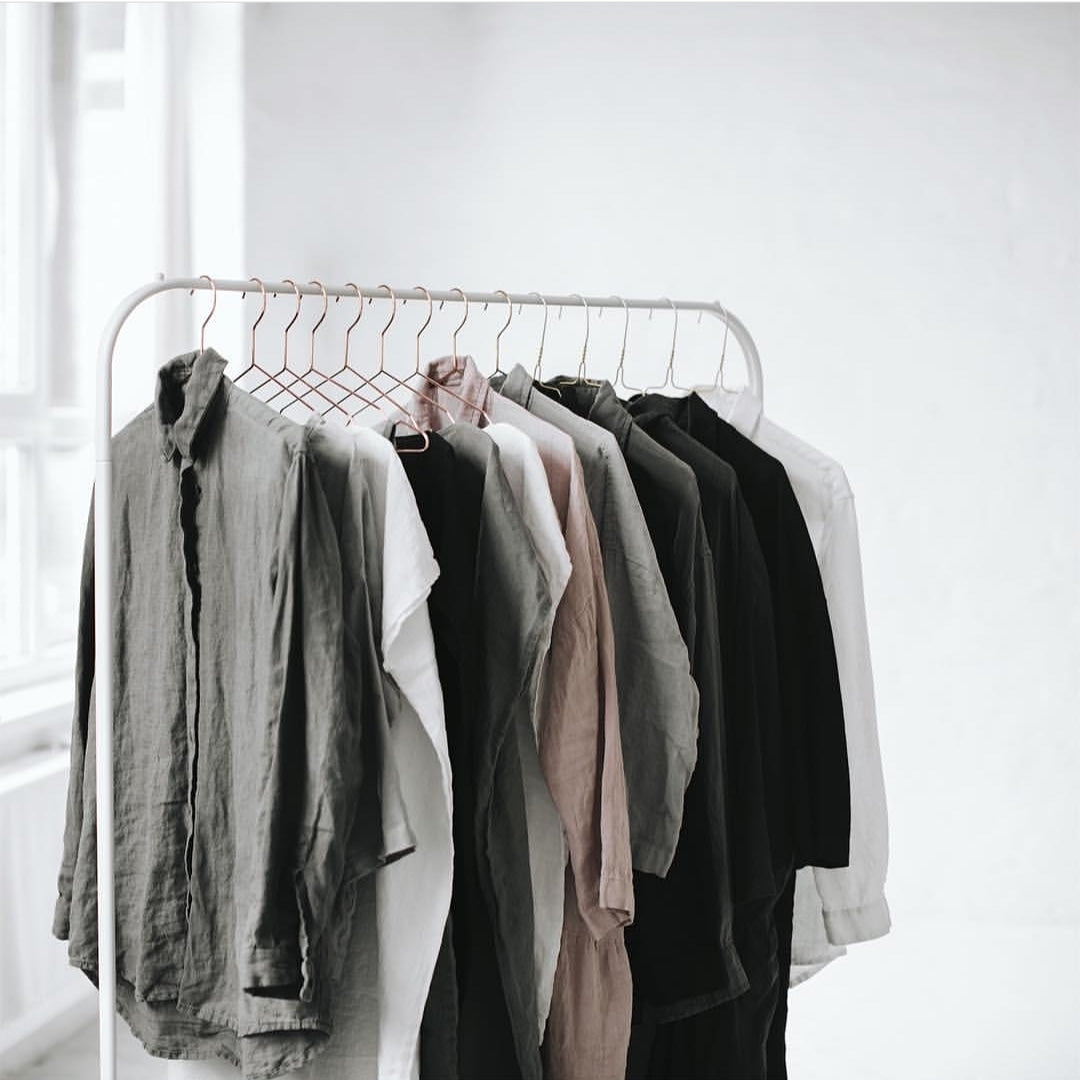An ethical fashion guide is your roadmap to building a wardrobe that's not just stylish, but also kind to the people who make your clothes and the planet we all share. It's about looking beyond the price tag to understand the real story behind your garments, championing fair worker treatment, sustainable materials, and animal welfare over the relentless churn of the fast-fashion cycle.
What Is Ethical Fashion, Anyway?

Let's be honest, the term 'ethical fashion' can feel a bit heavy, maybe even a little daunting. But it's not as complicated as it sounds. Think of it less like a rigid rulebook and more like a philosophy for how our clothes should be made. It's a conscious shift away from the disposable, high-speed model of fashion that's become the norm in New Zealand and across the globe.
At its heart, ethical fashion is about asking the tough but necessary questions. Who made my shirt? Were they paid a living wage? Did they work in a safe, healthy environment? It’s a powerful pushback against an industry where exploitation, low pay, and unsafe conditions are all too common for millions of workers.
The Pillars of Ethical Fashion
Ethical fashion isn't about ticking just one box; it's a holistic approach built on several core principles that work together. Here's a look at the fundamental pillars that define what makes fashion ethical.
| Pillar | What It Means For Your Clothes | Why It's a Game-Changer |
|---|---|---|
| Fair Labour & Human Rights | The people who made your garment were treated with dignity, paid a fair wage, and worked in safe conditions. | It actively fights exploitation and ensures the fashion industry supports livelihoods instead of profiting from hardship. |
| Environmental Sustainability | Your clothing is made from low-impact materials (like organic linen) using methods that conserve water, cut pollution, and minimise waste. | It reduces fashion's massive environmental footprint, protecting our ecosystems for future generations. |
| Animal Welfare | No animals were harmed to create your garment. Materials are cruelty-free, and practices like fur farming are rejected. | It ensures compassion is woven into your wardrobe, ending unnecessary animal suffering for the sake of style. |
| Transparency & Honesty | The brand is open about its production processes. You can easily find out where and how your clothes were made. | It empowers you to make genuinely informed choices and holds brands accountable for their promises. |
These pillars aren't just buzzwords; they represent a fundamental rethinking of how clothing is produced and consumed, putting people and the planet first.
Why This Movement Is Gaining Momentum
The move towards more conscious shopping isn't just a fleeting trend—it’s a powerful global movement. The ethical fashion market is set to grow from $8.77 billion in 2024 to $9.48 billion in 2025. This incredible growth is being fuelled by everyday shoppers who are waking up to the true social and environmental cost of fast fashion. You can explore the complete research on the ethical fashion market's growth to see how consumer demand is reshaping the industry.
Ethical fashion is the thoughtful response to the problems created by fast fashion. It offers a more humane and sustainable alternative by prioritising people and the planet over profit at any cost.
This guide is here to give you that foundational understanding. It’s designed to arm you with the practical knowledge to start building a wardrobe that doesn't just look good, but does good, perfectly aligning your personal style with your values.
Right, let's cut through the jargon. Diving into ethical fashion can feel a bit like learning a new language. You see all these different logos and "eco" claims splashed across clothing tags, and it’s tough to know what’s genuine and what’s just clever marketing. This section is your no-nonsense guide to figuring out which labels actually mean something here in New Zealand.
Think of certifications as a brand's promise, but with receipts. They are proof from an independent third party that a company is being held to a specific, measurable standard. Instead of just taking a brand’s word for it, these labels show they’re truly walking the talk on social and environmental responsibility.
They’re also your best defence against greenwashing—that frustrating trend where brands make fuzzy, misleading claims to appear more environmentally friendly than they really are. A credible certification cuts through all that noise, giving you a clear benchmark you can actually trust.
Key Certifications to Look For
Once you know the key players, navigating the world of certifications gets a lot easier. Each one has a slightly different focus, from organic fibres to fair labour practices. Here are three of the most respected and comprehensive certifications you’ll come across when shopping for ethical clothing.
-
Fair Trade: This one is all about people. It’s a guarantee that the farmers and workers behind your clothes, particularly in developing countries, are getting a fair deal. This means fair wages, safe working conditions, and extra funds for community development projects. Fair Trade is becoming a real cornerstone of ethical fashion in New Zealand, with the local association pushing for Kiwi brands to adopt these standards. You can learn more about how Fair Trade is shaping sustainable style in New Zealand to see its local impact.
-
Global Organic Textile Standard (GOTS): If a piece of clothing says it's organic, the GOTS logo is what you want to see. It’s the gold standard for organic textiles worldwide, covering the entire journey from harvesting the raw materials right through to socially responsible manufacturing. A GOTS-certified product must contain at least 70% certified organic fibres, and for something to be labelled 'organic' under this standard, it needs to hit a minimum of 95%. It also completely bans nasty, toxic chemicals from the production line.
-
B Corporation (B Corp): Think of this as a holistic health check for a business. The B Corp certification doesn't just look at a single product; it assesses a company’s entire social and environmental impact. To become a B Corp, a business has to meet seriously high standards of accountability and transparency in everything it does—from its supply chain and materials to employee benefits and how it gives back to the community. It’s a legal commitment to balancing profit with purpose.
A trustworthy certification is more than just a logo; it's a story of accountability. It tells you that a brand has opened its doors to independent scrutiny and is committed to upholding standards that protect both people and the planet.
Beyond the Big Three
While Fair Trade, GOTS, and B Corp are fantastic starting points, they’re not the only labels worth knowing. A few others offer valuable insights into specific parts of a garment’s journey. Spotting these can give you an extra layer of confidence in what you’re buying.
| Certification | What It Guarantees | Best For Checking |
|---|---|---|
| OEKO-TEX STANDARD 100 | Every single part of the item—from the thread to the buttons—has been tested for harmful substances. It's completely safe for your skin. | The safety and non-toxicity of the final textile product you are buying. |
| Cradle to Cradle Certified® | Products are designed for a circular economy. This means they are safe, responsibly made, and can be reused or returned safely to nature. | The full lifecycle of a product, from creation to its potential for reuse or safe return to nature. |
| bluesign® | The manufacturing process used resources responsibly and minimised its impact on people and the environment at every step. | The environmental safety of the chemical inputs and processes used in manufacturing. |
Getting familiar with these key certifications transforms you from a passive shopper into an informed one. You’ll have the power to look past the marketing fluff and put your money behind brands that are genuinely invested in building a better, more sustainable fashion industry. This knowledge is your most powerful tool.
Choosing Sustainable Materials for Your Wardrobe
The very fabric of your clothes is where your ethical fashion journey truly begins. Every textile has a story—from the way it was grown and processed to how it feels against your skin and how long it’ll last. Making informed choices here is one of the most powerful steps you can take.
This isn't about having to memorise complex production methods. It’s more about understanding the fundamental difference between materials that nourish our planet and those that deplete it. Think of it like choosing fresh, wholesome ingredients for a meal versus processed, factory-made food; the difference in quality, feel, and overall impact is huge.
The right fabrics can completely change your relationship with your clothes, shifting the focus towards quality and longevity.

As you can see, sustainable fabrics offer a unique combination of comfort and a gentler touch on the environment.
The Heroes of Your Wardrobe
Let's meet the champions of the textile world. These materials are celebrated not just for their lower environmental footprint but also for their incredible quality, feel, and durability. They’re the foundation of a wardrobe built to last.
-
Organic Linen: A true superstar. Linen comes from the flax plant, which thrives with far less water and fewer pesticides than conventional cotton. It’s incredibly strong, breathable, and actually gets softer with every wash, making it a perfect investment for the New Zealand climate.
-
Hemp: Much like linen, hemp is a wonderfully resilient plant. It grows quickly, naturally suppresses weeds, and needs very little water. The fabric it produces is durable, breathable, and even offers natural UV protection.
-
Organic Cotton: While its conventional counterpart is deeply problematic, organic cotton is a different story. Grown without toxic pesticides and synthetic fertilisers, it protects soil health, uses significantly less water, and is a much kinder choice for farmers and the planet.
-
TENCEL™ Lyocell: This is a fantastic example of modern textile innovation. It's made from sustainably sourced wood pulp in a closed-loop system, where over 99% of the water and solvents are recycled. TENCEL™ is famous for its silky-smooth feel, beautiful drape, and moisture-wicking properties.
Choosing a sustainable material is like casting a vote for a healthier planet. Each garment made from organic linen or hemp represents a choice for cleaner water, healthier soil, and a more resilient ecosystem.
Exploring the world of textiles can be fascinating. To dive deeper, you can discover more about the distinct qualities of various natural fabrics for clothes in our detailed article.
The Villains to Avoid
Just as there are heroes, some fabrics have a much darker side. These materials are the workhorses of fast fashion for one main reason: they're cheap to produce. But that low price tag hides an enormous environmental and social cost.
-
Conventional Cotton: Often called the world's 'thirstiest crop', conventional cotton is a real villain. It's responsible for 16% of the world's insecticide use, despite growing on just 2.5% of its agricultural land. This has devastating effects on waterways, wildlife, and the health of farmers.
-
Polyester (and other synthetics): At its core, polyester is plastic derived from petroleum. Its production is energy-intensive and releases harmful emissions. Worse still, every time you wash a polyester garment, it sheds thousands of tiny plastic microfibres that pollute our oceans and end up in the food chain.
A Practical Comparison
Sometimes, seeing the facts side-by-side makes the choice crystal clear. This isn't just about environmental theory; it's about building a wardrobe that performs better, feels better, and lasts longer.
Here's a straightforward look at how these fabrics stack up in the real world.
Sustainable Fabrics vs Conventional Fabrics
| Fabric Type | Environmental Impact | Feel and Durability |
|---|---|---|
| Organic Linen | Low water use, minimal pesticides, biodegradable. Flax plants improve soil health. | Highly durable, gets softer with age. Exceptionally breathable and cool, perfect for warm weather. |
| Conventional Cotton | Massive water consumption, heavy use of toxic pesticides and synthetic fertilisers, soil degradation. | Soft but can lose shape. Less durable than high-quality natural fibres like linen. |
| TENCEL™ Lyocell | Made from sustainable wood in a closed-loop process that recycles water and solvents. Biodegradable. | Silky, smooth, and drapes beautifully. Excellent moisture absorption and gentle on skin. |
| Polyester | Fossil fuel-based, energy-intensive production, non-biodegradable, sheds plastic microfibres when washed. | Can feel clammy and traps moisture. Prone to pilling and retaining odours over time. |
By getting familiar with these key differences, you can start reading labels with newfound confidence. This knowledge is your power—it empowers you to curate a wardrobe that you can feel truly good about, inside and out.
How to Build Your Ethical Wardrobe Without the Overwhelm
So, you're ready to make a change, but the thought of starting feels... big. I get it. Shifting to an ethical wardrobe can seem like a monumental task, but it doesn't have to be. Let's break it down into a practical roadmap for building a more conscious collection of clothes, one thoughtful step at a time.
The most crucial piece of advice I can give you is about a simple mindset shift. This isn't about a dramatic clear-out and a frantic shopping spree for a brand-new, certified-ethical wardrobe. In fact, the most sustainable and ethical first step is the exact opposite: start with what you already own.
Start by Shopping Your Own Closet
Before you even browse a single online store, take a good, honest look at the clothes already hanging in your wardrobe. Most of us are familiar with the 80/20 rule—we wear just 20% of our clothes 80% of the time. That means there's a whole lot of untapped potential hiding in there.
Set aside an afternoon, pull everything out, and start trying things on. Get a bit creative and mix and match pieces you haven't worn together before. You’ll almost certainly rediscover gems you used to love and find fresh outfit inspiration without spending a dollar. It’s a simple act of respect for the resources that went into making your clothes in the first place.
The most ethical garment is the one that's already in your wardrobe. Extending the life of your existing clothes is a powerful act of sustainability, reducing demand for new production and keeping textiles out of our landfills.
Embrace the Art of Mending and Care
A loose button or a small tear shouldn't mean the end of the road for a piece you love. Learning a few simple mending skills is incredibly empowering and forges a deeper connection to your clothing. You can find countless easy-to-follow tutorials online for basic stitches.
Just as important is proper care. Simply following the washing instructions can dramatically extend the life of your clothes. For instance, knowing the ins and outs of proper garment care to extend life for staples like denim makes a huge difference in preventing fading and wear. This commitment to caring for what you have is a cornerstone of the slow fashion movement.
Create a Versatile Capsule Wardrobe
A capsule wardrobe is essentially a small, curated collection of high-quality essentials that you can mix and match endlessly. The focus is on quality over quantity, championing timeless pieces that won't feel dated next season.
This approach not only simplifies your morning routine and cuts down on decision fatigue, but it also ensures that every single item you own is something you genuinely love and wear. It’s the ultimate expression of the "buy less, buy better" philosophy. For a deeper dive, learning how to buy less but better is a key skill for building a wardrobe that truly lasts.
To get started on your capsule, think about a core colour palette and versatile basics:
- A well-made pair of trousers or a classic skirt.
- High-quality t-shirts or tops in neutral colours.
- A timeless jacket or coat that works for multiple seasons.
- Durable shoes that are both comfortable and stylish.
Explore New Zealand's Secondhand Scene
When you're genuinely ready to add a new piece to your wardrobe, make secondhand your first port of call. New Zealand is lucky to have a fantastic, vibrant culture of op-shopping, pre-loved boutiques, and online marketplaces just waiting to be explored.
Shopping secondhand gives clothes a new life, slashing their environmental impact. It's a brilliant way to unearth unique, high-quality pieces—often from premium brands you might not buy new—for a fraction of the cost. From the local Sallies to online gems, it’s an adventurous and deeply sustainable way to find those special, artisanal pieces that tell a story and make your style entirely your own.
Championing Local and Artisan Fashion in Aotearoa

While global certifications provide a solid starting point, some of the most meaningful ethical choices happen right here in our own backyard. Championing local and artisan fashion in Aotearoa is one of the most powerful ways to bring the principles of this guide to life, connecting you directly with the heart and soul of Kiwi creativity.
Choosing to support local is so much more than a feel-good gesture; it’s a conscious decision with real, tangible benefits. Think of it as shortening the journey your clothes take to get to you. Instead of a complex, globe-spanning supply chain, your garment might travel from a workshop just down the road to your wardrobe. This dramatically shrinks its carbon footprint.
When you buy from a New Zealand designer, your money does more than just purchase a garment. It directly fuels our creative economy, supports a small business, and helps preserve the unique skills and artistry that make our fashion scene so special.
The Power of Local Connection
There’s a kind of magic in knowing the story behind your clothes, isn't there? Local fashion offers a transparency that massive international brands often struggle to match. You can meet the makers at markets, see their process, and understand their values firsthand.
This connection builds a much deeper appreciation for the skill and care woven into every seam. It turns a simple purchase into a meaningful relationship, fostering a sense of community and shared purpose. This local focus is fundamental to creating real change, empowering us to support the very fabric of our communities. To dive deeper into this idea, you can read our thoughts on fostering [https://www.thefoxesden.co.nz/blogs/the-foxes-den-blog/common-good-in-new-zealand].
Investing in local artisans is an investment in storytelling, heritage, and the future of craftsmanship in Aotearoa. It ensures that unique skills are passed down and that our local creative ecosystem continues to thrive.
The idea of strengthening domestic production has widespread benefits. By championing local fashion, it's helpful to understand the broader advantages of keeping things close to home. You can learn more about the importance of supporting local production to see how these principles apply on a larger scale.
Tackling Our Own Challenges
Supporting local also means we get to confront our own industry's challenges head-on. In 2023, New Zealand's fashion industry was a major economic driver, contributing $7.8 billion to our economy. But we also face a stark reality with textile waste, sending roughly 52,000 tonnes of clothing to landfills every single year.
This highlights a huge opportunity for Kiwi innovators to lead the way in circular solutions, and thankfully, many local designers are already rising to the occasion.
Here are just a few of the inspiring approaches you'll find happening right here in our local scene:
- Made-to-Order Models: Many Kiwi artisans—like us at The Foxes Den with our bespoke linen pieces—only craft a garment after an order is placed. This simple shift eliminates overproduction and ensures every single item is wanted and loved.
- Upcycling and Repurposing: Creative designers are giving old textiles a new lease on life, transforming discarded materials into beautiful, one-of-a-kind treasures.
- A Focus on Durability: Local makers almost always prioritise high-quality materials and construction. They’re creating timeless garments designed to be worn for years, not just a single season.
By seeking out and supporting these local champions, you’re doing so much more than buying a beautiful piece of clothing. You are actively taking part in building a more resilient, responsible, and uniquely Kiwi fashion future.
Your Ethical Fashion Questions Answered
Diving into the world of ethical fashion often opens up a flood of questions. It's completely normal to feel a mix of excitement and maybe a little uncertainty. Let's tackle some of those real-world concerns that might be on your mind.
We've pulled together the most common questions and worries people have when they start this journey. Our aim is to give you clear, honest answers so you can move forward with confidence. Think of this as your practical guide for navigating the world of conscious style.
Does Ethical Fashion Actually Cost More?
This is usually the first question on everyone's lips, and for good reason. At first glance, the price tag on an ethically made garment can look a lot higher than what you’d see in a fast-fashion store. It’s important to understand why that is.
An ethical price reflects the true cost of making something properly. This means paying garment workers a fair, living wage, choosing high-quality, sustainable materials like organic linen, and using manufacturing methods that don’t harm the planet. These aren't areas where corners should be cut.
The real game-changer, though, is thinking in terms of cost-per-wear. A cheaply made top that falls apart after three washes is no bargain. An ethically produced, durable garment that you'll love and wear for years offers so much more long-term value. It’s an investment in quality, not a throwaway purchase.
To make it work for your budget:
- Embrace secondhand: Op-shopping is your best friend for finding high-quality, affordable gems.
- Wait for sales: Keep an eye on your favourite ethical brands for end-of-season sales to grab those investment pieces at a better price.
- Focus on versatility: Before buying, make sure an item will work with at least three other things you already own.
How Can I Spot Greenwashing from a Mile Away?
Ah, greenwashing. It’s that frustrating trick where brands use vague, feel-good language to make themselves seem more environmentally friendly than they actually are. With words like "eco-friendly" and "conscious" thrown around so freely, it's easy to be misled.
The secret to seeing through it is to look for proof over promises. A genuinely ethical brand will be transparent and proud to show you the evidence behind their claims.
Greenwashing thrives on vague claims and pretty imagery. True ethical commitment is demonstrated through transparency, third-party certification, and specific, verifiable details about production.
Here’s a quick checklist to help you vet a brand’s claims:
- Check for specifics: Vague terms like "sustainably sourced" mean very little on their own. Look for details on which materials are used and why they are sustainable.
- Look for certifications: As we've covered, credible, third-party logos like GOTS, Fair Trade, or B Corp are strong signs of accountability. They prove a brand is walking the talk.
- Demand transparency: Can you easily find information on their website about where their clothes are made? A lack of clarity about their factories is a major red flag.
What Is the Single Best Change I Can Make Today?
It might surprise you, but the most powerful change you can make today has nothing to do with buying anything new at all. It’s about shifting your mindset and changing the relationship you have with the clothes already hanging in your wardrobe.
The single best change is to buy less and make what you have last longer.
This simple idea cuts through all the noise. Before you even think about a new purchase, try the "30 wears test." Ask yourself honestly, "Will I wear this at least 30 times?" If the answer is a hesitant "no," then it probably isn’t a worthwhile addition to your life.
This mindful approach encourages you to fall back in love with the pieces you already own, learn basic mending skills to extend their life, and see your wardrobe as a curated collection, not a revolving door of passing trends.
What Should I Do with Clothes I No Longer Want?
Giving your old clothes a responsible second life is a crucial part of the ethical fashion cycle. The main goal here is to keep textiles out of New Zealand's landfills, where they contribute to waste and harmful emissions.
Just follow this simple hierarchy for the best approach:
- Repair or Upcycle First: Could a simple mend bring an item back to life? Could you get creative and upcycle it into something new, like turning old linen into handy cleaning cloths?
- Swap, Sell, or Consign: What you’ve fallen out of love with could be someone else’s perfect find. Try clothing swaps with friends, sell items online, or use local consignment stores.
- Donate Thoughtfully: If an item is still in good, wearable condition, donate it to a reputable local charity shop. Just make sure it’s clean and something someone would genuinely want to wear.
- Textile Recycling as a Last Resort: For clothes that are too worn out to be passed on, look into textile recycling options in your area. While this is still a developing field in New Zealand, it's the final, best option to keep those fibres in circulation.
At The Foxes Den, we believe in the power of conscious choices, from our bespoke, made-to-order New Zealand linen clothing to our curated homewares. Our commitment to artisanal quality and timeless design ensures every piece is an investment in beauty and longevity. Explore our collection and build a wardrobe and home that reflect your values. Visit us at https://www.thefoxesden.co.nz.


